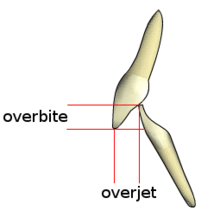Overbite
| Overbite | |
|---|---|
| Classification and external resources | |
| ICD-10 | K07.2 |
| ICD-9 | 524.29 |

Overbite commonly refers to a lower jaw being too far behind the upper jaw (retrognathia) or a misalignment of the teeth. Medically, the term refers to the extent of vertical (superior-inferior) overlap of the maxillary central incisors over the mandibular central incisors,[1] measured relative to the incisal ridges.[2]
The term overbite does not refer to a specific condition, nor is it a form of malocclusion. Rather an absent or excess overbite would be a malocclusion. Normal overbite is between 3–5 mm (or approximately 20–30% of the height of the mandibular incisors) and is commonly expressed as a percentage.
Other terms confused with "overbite"
Overbite is often confused with overjet, which is the distance between the maxillary anterior teeth and the mandibular anterior teeth in the anterior-posterior axis.
"Overbite" may also be used commonly to refer to Class II malocclusion or retrognathia, though this usage can be considered incorrect by some. This is where the mesiobuccal cusp of the maxillary first molar is situated anterior to the buccal groove of the mandibular first molar; in other words, the mandible (lower jaw) appears too far behind the maxilla. A person presenting with Class II malocclusion may exhibit excessive overbite as well. It is also possible to have the opposite problem, which is referred to as openbite, which can occur in the anterior or posterior. In this case the teeth do not overlap enough or at all. The upper teeth stick out past the lower teeth.
References
| |||||||||||||||||||